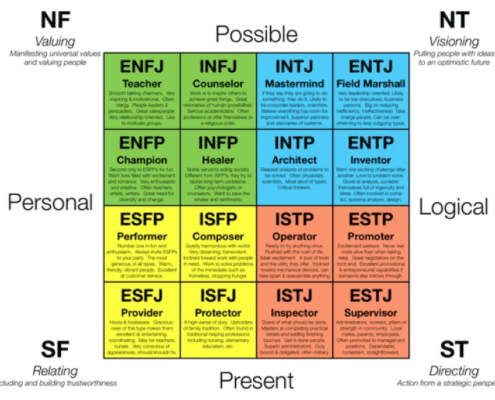MBTI Training For Sales Teams – Part 3
MBTI Training: Flexing selling style to better connect
In our previous posts on MBTI training for sales teams we have looked at each of the four MBTI ‘scales’ and have addressed three vital questions:
- How do we spot this characteristic with confidence
- What selling style/techniques a customer with this style type best respond to ?
- How best to communicate with each style type
The four scales lead to sixteen model ‘types’ as shown in the grid below –

We would stress that return on investment in MBTI training only comes when improved sales [ volume/profit] are realised. Hence our focus is firmly on ‘doing things differently’. Let’s see how this works in practice.
In our MBTI training we outline a four step process as follows –
Step 1 – know yourself. How will you naturally sell unless you consciously flex ?
Step 2 – make your best guess as to the customers style type based on observed clues
Step 3 – assess the gap between your natural style of selling and the ‘best –fit’ for the customer
Step 4 – decide your flexes, execute the sale and review
In training the sale is then observed and feedback provided as to how well a strong and rapport building connection has been made. If necessary the sale is then repeated until genuine rapport is being built.
Let’s imagine a sales person who knows they are type ISTJ [ Step 1 ] selling to a customer where several clues lead to the conclusion that they are ESFP [ Step 2 ]. Let’s consider the key aspects of ‘the gap’ in this case [ Step 3 ] –
The ISTJ sales person is likely to – be fairly reserved in both body language and tone of communication. Likely to present facts in a logical and step by step way. Perhaps fail to consider people – preferring processes. Be quite formal and highly planned.
Note – in training significant time is spent exploring ones natural style of sales delivery so a richer picture will emerge.
The ESFP customer is likely to respond best to – energy, passion, enthusiasm, physical samples or a chance to try the product for themselves, will consider impact on people before making decisions and likely to respond well to flexibility and spontaneity
Based on the above thinking the sales person decides to [ Step 4 ]
- Be a little more animated / passionate when presenting ideas – tone and body language
- Think about motivational words she can use to ‘paint the picture’ of the future
- Takes her presentation down from 20 slides to 8 [ details as a leave-piece ]
- Removes words and replaces with images in her presentation
- Ensures the impact of decisions on people within the customers organisation is a key part of her presentation
- Looks to down weight formal detailed plans and enthuses about the flexibility and ability to respond to actual day-to-day results in the proposed way of working
The six small adjustments detailed above when viewed holistically have the ability to completely transform the impact of the selling pitch to one which the customer truly embraces and in which rapport can be seen building from the start.
Practicing these skills can move your sales people to an advanced and genuinely customer centric level of operation.
If you would like to discuss your MBTI training needs please contact us or Tweet to @customerattune or Tweet to @MarkHollyoake, or email us at hello@customerattuned.com.
Read more about MBTI Training:
- Sales and Account Management Development
- MBTI for Sales Teams Pt 1
- Training and Developing Your People
- Excessive Trust – When Trust Goes Wrong - October 29, 2024
- Identification Based Trust - October 21, 2024
- Introducing Knowledge Based Trust - October 15, 2024


